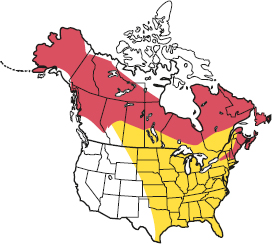Setophaga striata

male
The Blackpoll Warbler is a strikingly marked little songbird. The sexes are dissimilar. Adult summer males have a dark, streaked back and nape, with a black cap, white face, and black malar stripe. The black wings have two bold white wingbars. The underparts are white with bold black streaks on the flanks. Adult summer females appear grubby by comparison, and the head is streaked olive-gray except for the pale throat and dark malar stripe. Adults in fall are similar to a summer female. Immatures are similar to a fall adult, but the upperparts are olive-yellow and the face is brighter yellow. The underparts are olive-yellow, subtly streaked on the flanks and grading to white on the undertail. All birds have orange legs and feet. Compared to an immature Bay-breasted Warbler, an immature Blackpoll Warbler has orange-yellow (not dark) legs and feet, and a white (not buff) undertail.
The Blackpoll Warbler is present as a breeding species in northern forests of North America mainly from June to August. It spends the rest of the year in northern South America. Birds feed in a relatively slow, deliberate manner.

female
FACT FILE
LENGTH 5.5 in (14 cm)
FOOD Invertebrates
HABITAT Boreal forests
STATUS Widespread and common summer visitor
VOICE Song is a series of very high-pitched tsi-tsi-tsi . . . notes. Call is a sharp chip
![]()
